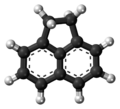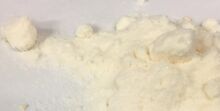Chemistry:Acenaphthene

| |

| |

| |
| Names | |
|---|---|
| Preferred IUPAC name
1,2-Dihydroacenaphthylene | |
| Other names
1,8-Ethylenenaphthalene
peri-Ethylenenaphthalene Naphthyleneethylene Tricyclo[6.3.1.04,12]dodecapentaene Tricyclo[6.3.1.04,12]dodeca-1(12),4,6,8,10-pentaene | |
| Identifiers | |
3D model (JSmol)
|
|
| ChEBI | |
| ChEMBL | |
| ChemSpider | |
| EC Number |
|
| KEGG | |
PubChem CID
|
|
| RTECS number |
|
| UNII | |
| UN number | 3077 |
| |
| |
| Properties | |
| C12H10 | |
| Molar mass | 154.212 g·mol−1 |
| Appearance | White or pale yellow crystalline powder |
| Density | 1.024 g/cm3 |
| Melting point | 93.4 °C (200.1 °F; 366.5 K) |
| Boiling point | 279 °C (534 °F; 552 K) |
| 0.4 mg/100 ml | |
| Solubility in ethanol | slight |
| Solubility in chloroform | slight |
| Solubility in benzene | very soluble |
| Solubility in acetic acid | soluble |
| Vapor pressure | 0.001 to 0.01 mmHg at 68°F ; 5 mmHg at 238.6°F[1] |
| -.709·10−6 cm3/g | |
| Thermochemistry[2] | |
Heat capacity (C)
|
190.4 J mol−1 K−1 |
Std molar
entropy (S |
188.9 J mol−1 K−1 |
Std enthalpy of
formation (ΔfH⦵298) |
70.3 kJ/mol |
| Hazards | |
| Safety data sheet | ICSC 1674 |
| NFPA 704 (fire diamond) | |
| Flash point | 135 °C (275 °F; 408 K) |
| > 450 °C (842 °F; 723 K) | |
Except where otherwise noted, data are given for materials in their standard state (at 25 °C [77 °F], 100 kPa). | |
| Infobox references | |
Acenaphthene is a polycyclic aromatic hydrocarbon (PAH) consisting of naphthalene with an ethylene bridge connecting positions 1 and 8. It is a colourless solid. Coal tar consists of about 0.3% of this compound.[3]
Production and reactions
Acenaphthene was prepared the first time from coal tar by Marcellin Berthelot.[4] Later Berthelot and Bardy synthesized the compound by cyclization of α-ethylnaphthalene. Industrially, it is still obtained from coal tar together with its derivative acenaphthylene (and many other compounds).
Like other arenes, acenaphthene forms complexes with low valent metal centers. One example is (η6-acenaphthene)Mn(CO)3]+.[5]
Uses
It is used on a large scale to prepare naphthalene dicarboxylic anhydride, which is a precursor to dyes and optical brighteners.[3] Naphthalene dicarboxylic anhydride is the precursor to perylenetetracarboxylic dianhydride, precursor to several commercial pigments and dyes.[6][7]
References
- ↑ National Toxicology Program, Institute of Environmental Health Sciences, National Institutes of Health (NTP). 1992. National Toxicology Program Chemical Repository Database. Research Triangle Park, North Carolina
- ↑ John Rumble (June 18, 2018) (in English). CRC Handbook of Chemistry and Physics (99th ed.). CRC Press. pp. 5–3. ISBN 978-1138561632.
- ↑ 3.0 3.1 Griesbaum, Karl; Behr, Arno; Biedenkapp, Dieter; Voges, Heinz-Werner; Garbe, Dorothea; Paetz, Christian; Collin, Gerd; Mayer, Dieter et al. (2000). "Ullmann's Encyclopedia of Industrial Chemistry". Ullmann's Encyclopedia of Industrial Chemistry. Weinheim: Wiley-VCH. doi:10.1002/14356007.a13_227.
- ↑ Karl Griesbaum, Arno Behr, Dieter Biedenkapp, Heinz-Werner Voges, Dorothea Garbe, Christian Paetz, Gerd Collin, Dieter Mayer, Hartmut Höke (2000-06-15). Wiley-VCH Verlag GmbH & Co. ed (in en). Hydrocarbons. Ullmann's Encyclopedia of Industrial Chemistry.
- ↑ S. B. Kim, S. Lotz, S. Sun, Y. K. Chung, R. D. Pike, D. A. Sweigart "Manganese Tricarbonyl Transfer (MTT) Agents" Inorganic Syntheses, 2010, Vol. 35, 109–128. doi:10.1002/9780470651568.ch6
- ↑ K. Hunger. W. Herbst "Pigments, Organic" in Ullmann's Encyclopedia of Industrial Chemistry, Wiley-VCH, Weinheim, 2012. doi:10.1002/14356007.a20_371
- ↑ Greene, M. "Perylene Pigments" in High Performance Pigments, 2009, Wiley-VCH, Weinheim. pp. 261-274.doi:10.1002/9783527626915.ch16
 |



